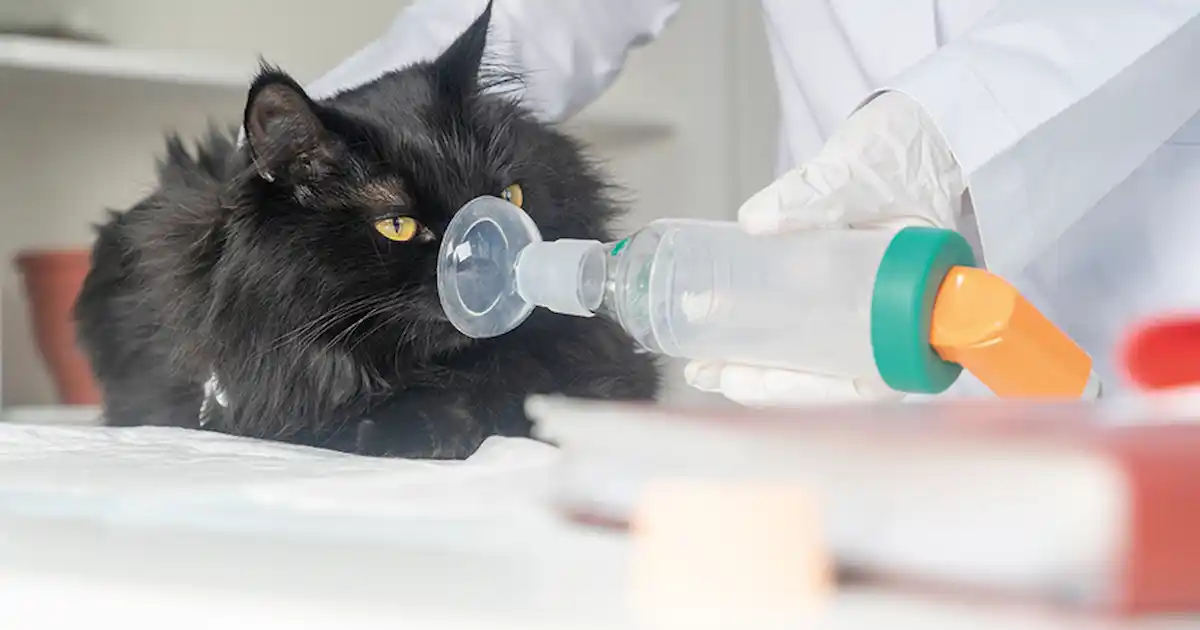Treatment Instructions for Asthma and Bronchitis in Cats – Cats can suffer from asthma and bronchitis, which can have a greatly negative impact on their quality of life. Both diseases are characterized by inflammation within the airways. Asthma generally includes a bronchoconstriction component, whereas bronchitis presents more as excessive mucus production and chronic cough. Knowing how to properly treat your cat for either asthma or bronchitis is critical to managing the respiratory symptoms to allow your pet to live an active, comfortable lifestyle.
Identifying the Signs and Symptoms
To successfully treat either of these diseases, the first part of the equation is recognizing if your cat has one of these respiratory diseases. Symptoms include –
- Persistent cough or intermittent hacking
- Wheezing or other audible breathing sounds
- Open-mouth breathing or labored breathing
- Decreased activity or lethargy
- Cyanosis (blue gums/tongue in an extreme case)
If your cat is displaying any of these symptoms, you should consult a veterinarian immediately. A complete and thorough diagnosis will help determine if your pet has bronchitis, asthma, or another disease that is affecting respiratory health.
Diagnosis and Differentiation
Veterinary medicine will typically perform several diagnostic tests to identify the cause of respiratory distress. These tests may include the following –
- Chest x-rays to look for inflammation or mucus in the lungs
- Bronchoalveolar lavage (BAL) to collect and evaluate cells in the airways
- Blood tests to identify diseases such as feline leukemia
- Testing for Allergies in Cases Suspected to be Asthma
Asthma in cats is often instigated by allergens such as pollen, dust, mold, or cigarette smoke, while bronchitis may arise from bacterial or viral infection, environmental irritants, or chronic inflammation.
Treatment Recommendations for Asthma in Cats
1. Corticosteroids
These are the foundation of the treatment of asthma in cats. The purpose of corticosteroids is to reduce airway inflammation and to prevent asthma flare-ups.
Options for oral treatment – Prednisolone is most commonly prescribed. Available in tablets or liquid form.
Inhaled steroids – Fluticasone can be administered via the feline inhaler. Inhaled corticosteroids are likely better tolerated with fewer systemic adverse effects than oral medication.
2. Bronchodilators
These are medications to open the airways during acute asthma attacks. Bronchodilators should not take the place of corticosteroids; rather, bronchodilators are good for quick relief.
- The bronchodilators more commonly used are albuterol by inhaler.
- Administer inhalers with a spacer device made specifically for cats.
3. Environmental Control Measures
- Use HEPA filters to reduce indoor allergens.
- Avoid smoking in the house and limit the use of aerosol-based sprays.
- Regularly vacuum and dust to minimize exposure to dust mites and dander.
4. Monitoring and Follow-up
- You and your veterinarian can keep a log of coughing episodes and the cat’s breathing pattern.
- Make sure to have check-ups with your veterinarian to monitor lung function.
- As your cat is on medications, remember to adjust medications according to your veterinarian’s recommendations.
Instructions for Treatment of Bronchitis in Cats
1. Antibiotics (If Bacterial Infection is Diagnosed)
If your veterinarian identifies a bacterial infection, they may prescribe antibiotics like doxycycline or amoxicillin-clavulanate.
2. Anti-Inflammatory Medications
Corticosteroids are also used in chronic bronchitis to reduce inflammation and mucus production.
3. Nebulization therapy
Some veterinarians may ask you to provide nebulization with saline or bronchodilators to reduce mucus and improve your cat’s breathing. However, some veterinarians may use this as a treatment in the clinic and advise you and/or assist you with this as part of your home-care regimen.
4. Cough Suppressants (Rarely Used)
Cough suppressants should only be used under the supervision of your veterinarian if your cat is suffering from severe, non-productive coughing. When cough suppressants are overused, they inhibit the body from being able to clear the mucus.
5. Hydration and Nutrition
Hydration is important to enterate water-“thins out the mucus”. Nutrition with a balanced diet will provide your cat with he nutrients necessary to bolster the immune system and assist recovery.
6. Environmental Changes
Similar to asthma management, it is important to minimize exposure to airborne irritants such as cigarette smoke, perfumes, fragrances, and cleaning products.
Preventive and Home Care Measures
Follow-up care is important, and while nothing is “cured” with asthma or chronic bronchitis in cats, it is possible to manage it and see your cat thrive with a good quality of life in the long term. There are ways to minimize additional flare-ups to manage the condition effectively. The following are preventive home care measures –
- Keep your house clean and free of allergens.
- Use dust-free or low-dust cat litter.
- Do not allow your cat to go outside during peak pollen seasons.
- Keep an eye out for any new or worsening symptoms.
Emergency Protocols
If your cat is in a serious respiratory crisis and is panting, open-mouth breathing, or experiencing cyanosis, seek immediate emergency veterinary treatment. These episodes can be life-threatening situations if not treated immediately. Your vet will be able to offer oxygen therapy, injectable steroids, and bronchodilators in an emergency facility.
Conclusion
Asthma and bronchitis in cats can be successfully managed with a combination of veterinary treatment, medications, and lifestyle changes in the home. By adhering to clear instructions for treatment and having good communication with your vet, your cat can live a comfortable and active life despite the presence of respiratory disease.
For more useful pet-care tips and quality adapted treatments to suit your cat’s health, visit Pet Care Partners – A trusted partner in pet wellness and comfort.
FAQs About Asthma and Bronchitis in Cats
Can I use a human inhaler on my cat with asthma?
No, human inhalers are not intended for use in cats. Although some of the medications may overlap, they must be delivered via a cat inhaler spacer. Always consult your veterinarian before giving any medication to your cat.
For how long do I have to treat my cat for asthma or bronchitis?
Both asthma and chronic bronchitis require long-term treatment, and often lifelong management. Your cat’s treatment may vary depending on how severe and how frequent the symptoms occur. However, if you do not wean your cat off the medications as recommended, then the risk of the symptoms reoccurring, or even getting worse, may develop.
Will my cat have a normal life with asthma or bronchitis?
Yes, cats with asthma or bronchitis can continue to have full, fulfilling, happy lives with treatment and management. If asthma or chronic bronchitis is caught early, owners treat their cats properly with medication, and members of the household control the irritants in their environment, symptoms can remain stable and hopefully, at an acceptable level
Is it ok to manage my cat’s treatment at home when there is a flare in symptoms caused by stress?
Minor symptoms should be manageable at home with veterinary direction, like prescribed inhalers or nebulizers. Certainly, if your cat exhibits signs of severe respiratory distress, veterinary evaluation is needed immediately – your cat needs to be seen as soon as possible.




